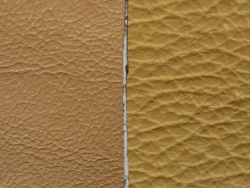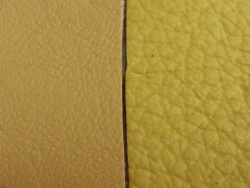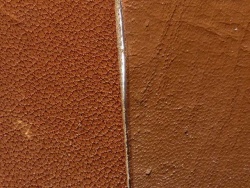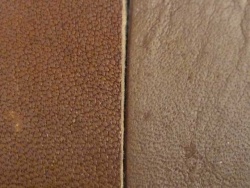Difference between revisions of "Metamerism"
| Line 4: | Line 4: | ||
| − | In colour theory, metamerism is the property of dyes | + | In colour theory, metamerism is the property of dyes for creating a different colour impression, depending on the spectral composition of the ambient light. |
| − | Two leather surfaces which are apparently identically coloured under daylight, can suddenly drastically deviate from one another with the aid of artificial light. What looks grey under a light bulb may suddenly appear violet in the sunlight, become blue or even more yellow. | + | Two leather surfaces, which are apparently identically coloured under daylight, can suddenly drastically deviate from one another with the aid of artificial light. What looks grey under a light bulb may suddenly appear violet in the sunlight, become blue or even more yellow. Customers have noticed this when buying clothing. The new acquisition looks a completely different shade in the shop than on the street, which is particularly annoying when you wanted the clothing to match something in an existing colour. |
The reason for this shift in perception lies in the functioning of the human visual sense. In addition to the sensors for the brightness of the visual impression, the eye has only three types of receptors that are sensitive in the red, green and blue range of the visible light (350-780 nm wavelength). If red light of 750 nm is incident on the eye, a red light impression will also appear in the brain. It is also possible with a clear yellow light of 580 nm. But the yellow impression can also arise when pure red light (eg at 700 nm) and green light (500 nm) are mixed. The brain therefore does not distinguish between the yellow perception and whether it is pure light or any mixed light combined. The spectral composition of the ambient light is crucial in how the colour impression of an object changes. | The reason for this shift in perception lies in the functioning of the human visual sense. In addition to the sensors for the brightness of the visual impression, the eye has only three types of receptors that are sensitive in the red, green and blue range of the visible light (350-780 nm wavelength). If red light of 750 nm is incident on the eye, a red light impression will also appear in the brain. It is also possible with a clear yellow light of 580 nm. But the yellow impression can also arise when pure red light (eg at 700 nm) and green light (500 nm) are mixed. The brain therefore does not distinguish between the yellow perception and whether it is pure light or any mixed light combined. The spectral composition of the ambient light is crucial in how the colour impression of an object changes. | ||
| − | For companies that professionally deal with colouring of fabrics and leather, the metamorphic effect must be taken into account in production. To avoid colour changes under different light sources, | + | For companies that professionally deal with colouring of fabrics and leather, the metamorphic effect must be taken into account in production. To avoid colour changes under different light sources, work pieces are tested under different light conditions. The choice of suitable pigments and their combinations is essential in order to minimise colour deviations as far as possible. However, these are never completely excluded. |
Revision as of 11:31, 18 April 2017
In colour theory, metamerism is the property of dyes for creating a different colour impression, depending on the spectral composition of the ambient light.
Two leather surfaces, which are apparently identically coloured under daylight, can suddenly drastically deviate from one another with the aid of artificial light. What looks grey under a light bulb may suddenly appear violet in the sunlight, become blue or even more yellow. Customers have noticed this when buying clothing. The new acquisition looks a completely different shade in the shop than on the street, which is particularly annoying when you wanted the clothing to match something in an existing colour.
The reason for this shift in perception lies in the functioning of the human visual sense. In addition to the sensors for the brightness of the visual impression, the eye has only three types of receptors that are sensitive in the red, green and blue range of the visible light (350-780 nm wavelength). If red light of 750 nm is incident on the eye, a red light impression will also appear in the brain. It is also possible with a clear yellow light of 580 nm. But the yellow impression can also arise when pure red light (eg at 700 nm) and green light (500 nm) are mixed. The brain therefore does not distinguish between the yellow perception and whether it is pure light or any mixed light combined. The spectral composition of the ambient light is crucial in how the colour impression of an object changes.
For companies that professionally deal with colouring of fabrics and leather, the metamorphic effect must be taken into account in production. To avoid colour changes under different light sources, work pieces are tested under different light conditions. The choice of suitable pigments and their combinations is essential in order to minimise colour deviations as far as possible. However, these are never completely excluded.
Metameric effect with two leather patterns. Left: daylight - right: artificial light. Above, the patterns in artificial light are much more yellowish. Below, the patterns are much redder in daylight.
Additional information












 a kotori web solution
a kotori web solution